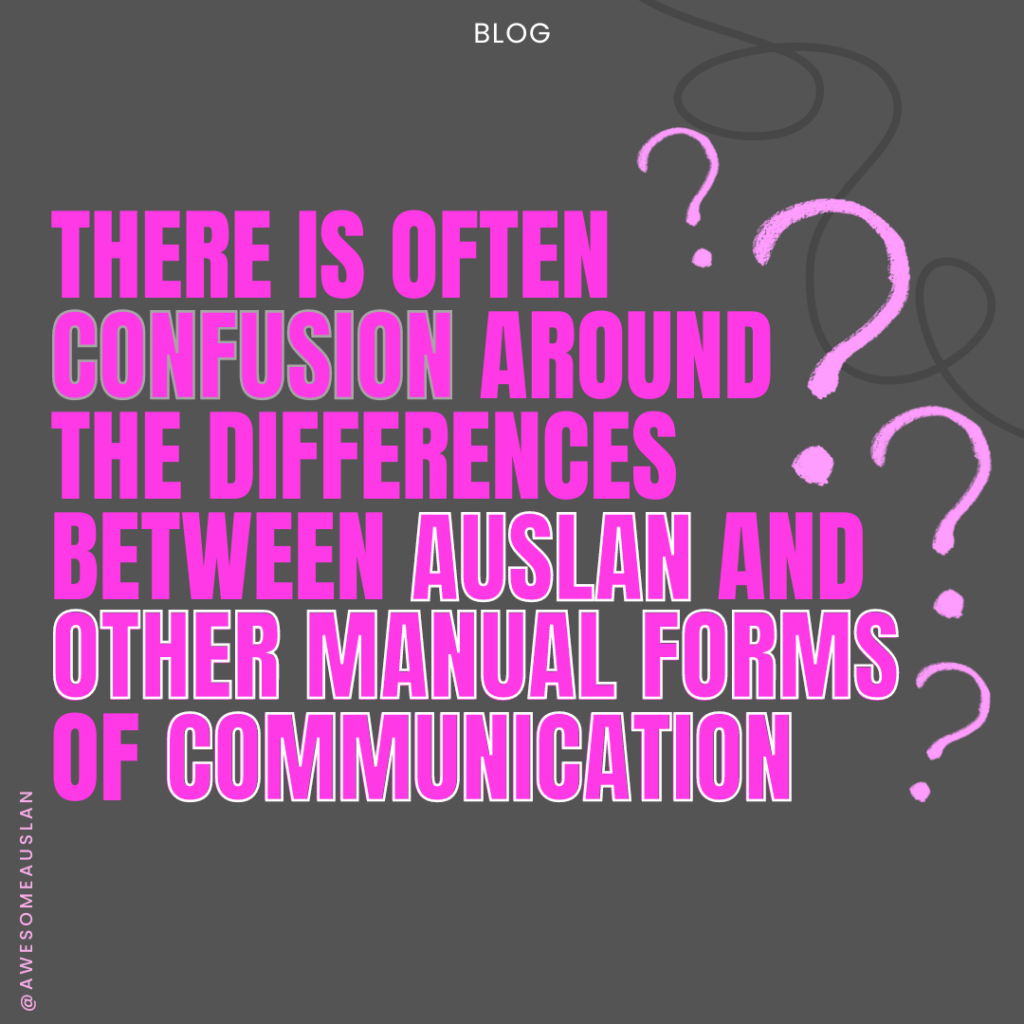The word manual means ‘relating to or done with the hands.’ From this we can surmise that manual forms of communication refer to communication done with and involving the hands.
There is often confusion around the differences between Auslan and other manual forms of communication that may be seen, known, or used throughout Australia.
Firstly, let’s look at Auslan then compare each of these other manual forms of communication to Auslan.
Auslan stands for Australian Sign Language. Auslan is a natural language in its own right, with its own vocabulary and grammatical structure. It is quite distinct from English. Auslan is the visual and spatial language of the Deaf community in Australia and it doesn’t use voice at all. (NOTE – there are Indigenous sign languages too, but for the purpose of this blog, we’ll be focusing on Auslan).
Sign languages are different all over the world; many countries have their own sign language.
Many new people and parents who want to learn or are curious about sign language often turn to Google. When typing ‘sign language’ into Google it will most likely bring up ASL content as ASL has a lot more content online than Auslan. ASL stands for American Sign Language.
It can easily be understood why people might assume that ASL stands for Australia Sign Language as they share the same acronyms however ASL means American Sign Language and Auslan is Australian Sign Language.
Because Australia and the USA are predominantly English-speaking countries some people assume that their signed languages must be similar too. This is incorrect.
ASL and Auslan are very different languages; the two barely share any commonality. The reason for this is that Auslan comes from Britain and ASL comes from France. At a fundamental level they are different and we see this when comparing their manual alphabets: Auslan has a two-handed alphabet where ASL has a one-handed alphabet.
*(See blog: We Are Not The Same: Australian Sign Language (Auslan) and American Sign Language (ASL))
Where Auslan and ASL do share similarities is that they are natural languages and they are voiceless. This is the most noticeable difference between Auslan/ASL and the next manual forms we’ll look at next.
Key Words Signs Australia (KWSA) was formerly known as Makaton Australia (name changed in 2010). This system borrows signs from Auslan and uses these signs to punctuate and accentuate key words as they are spoken. KWSA is NOT a language, it is a communication tool. This is often used for very young children, people with physical disabilities that impede speech, or cognitive delays which impairs their communication.
(Australasian) Signed English, like KWSA, is also not a language. It is a contrived and unnatural artificial communication system created for use in the education sector in the late 1970s. Its intention was to match a sign for each spoken English word with the hopes of improving literacy development of deaf students who used sign language.
While its use was only ever meant to be used in educational settings, inevitably students grew up, left school and continued to use Signed English in the Deaf community – where they could not be understood.
Signed English borrowed a lot of signs from Auslan and where English words didn’t have a sign, these were made up or adapted (for example, ‘is’, ‘it’, ‘was’, ‘the’, ‘and’, etc) with other signs borrowed from ASL. Fingerspelling was also used. Signed English was and is largely rejected by the Deaf community in Australia and is no longer used in schools.
Baby Signs For parents looking for ‘baby’ signs I ask them to consider this: what are baby signs? Are there baby English programs? The concept is simply focusing on some basic words/signs that are helpful and useful for a baby to communicate their needs. Humans tend to develop hand dexterity before vocal control and therefore being able to communicate manually can aid basic communication between baby and parents/adults. I often tell people who are looking for ‘Baby Signs’ to look into KWSA.
Simultaneous Communication Simultaneous Communication (SimCom) is a technique whereby speech and Auslan are used at the same time. Many teachers of the deaf tend to use this form of instruction. The risk is when attempting to use two distinct languages simultaneously, one of the languages will be degraded. As many teachers of the deaf are hearing, it is often the signed language that is compromised.
Hope you found this handy and keep up your Awesome Auslan!
Disclaimer This information is entirely subjective and based on my personal experience, interpretation and understanding of the subject matter.

As a Deaf person who has used, loved, and continued to learn Auslan throughout my life, it was when I started studying the Diploma of Auslan (Deaf cohort 2018) that I was awestruck by how beautifully complex Auslan is.

